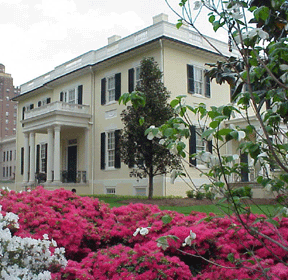On 16 March 2013, Virginia’s Executive Mansion celebrated its 200th anniversary with a birthday party at the Library of Virginia. The highlight of the event was a public screening of a new Mansion documentary, First House, produced by Blue Ridge PBS in partnership with Appeal Productions. The Library of Virginia and Citizens’ Advisory Council for Interpreting and Furnishing the Executive Mansion also published a commemorative book, First House: Two Centuries with Virginia’s First Families, written by Mary Miley Theobald. Out of the Box decided to jump on the bandwagon with a post highlighting some of the archival records about the Executive Mansion at the Library.
Plat showing Governor's House, kitchens, ravine, gardens and private property to be purchased.
Virginia General Assembly, House of Delegates, Speaker, Executive communications, Report, valuation, and plat, 1813 February 17. Accession 36912, State government records collection, The Library of Virginia.
The history of the Executive Mansion (also called Governor’s House or Governor’s Mansion) is well represented in the Library’s archival collections. The Auditor of Public Accounts, Capital Square Data Records, 1779-1971, document the construction, furnishing, and repair of the 1813 Executive Mansion and the various buildings used by the governor prior to the Mansion’s construction. The Drawing and Plans Collection includes a photographic copy of a page from Alexander Parris’ sketchbook depicting the floor plan for the Virginia Governor’s Mansion. Parris designed the mansion in 1811-1812. An Executive Communication to the Speaker of the House of Delegates, dated 17 February 1813, includes photocopy of a report from David Bullock, William McKim, and Robert Greenhow, the commissioners appointed to superintend the building of the dwelling house, and other houses, for the accommodation of the governor. The commissioner’s report provides the cost of the dwelling house and out houses and a few details on the exterior and interior of the building. Also included is a plat showing the Governor’s House, kitchens, ravine, gardens, and private property to be purchased.
Repairs and improvements to the Executive Mansion are a common theme. Records in the papers of Governors William Smith (1846-1849), Joseph Johnson (1852-1856), Francis Pierpont (1865-1868), Andrew Montague ((1902-1906), and William Mann (1910-1914) describe various repairs and improvements to the Mansion. The Records of the Secretary of the Commonwealth include a 2 June 1865 inventory of the Executive Mansion. Contracts and invoices for Mansion services and expenditures can be found in records of the Virginia Land Office and Virginia Department of the Treasury. The Records of the Executive Mansion Director, 1973-1995, document the work of the Citizens’ Advisory Council for Interpreting and Furnishing the Executive Mansion, events at the Mansion, and the 175th anniversary of the Mansion in 1988.
Under the administration of James S. Gilmore, III (1998–2002), Virginia’s Executive Mansion underwent an extensive renovation in 1999–2000. This project is well documented in two collections: Virginia Secretary of Administration, Correspondence and subject files, 1998-2001 and Sadler and Whitehead, Architects, Papers, 1992-2001. The Secretary of Administration records include episodes of Bob Vila’s Home Again: Renovation of the Executive Mansion, 1999-2000. As part of the 1999-2000 restoration, the Commonwealth’s Department of Historic Resources hired the firm of Sadler and Whitehead, Architects, PLC, to document the entire project, especially those previously hidden aspects of construction and ornamentation, using photography and descriptive commentary. Excavation, demolition, conservation, and new construction were all copiously documented by Mary Harding Sadler and Joseph D. Lahendro. Their materials include not only written information about their observations, but also hundreds of photographs capturing original interiors, decorative items, and structural elements of the Executive Mansion, Guest House/Cottage, Carriage House, and grounds. The Library turned this material into the Executive Mansion Rehabilitation Project Database, available on-line. The database records may contain all or some of the following information: weather conditions, photographs, observational notes, location in the specific building, information source, work type, report author, and date.
These are just some of the records about the Executive Mansion at the Library. To see what else we have on the Executive Mansion, search the Library’s on-line catalog.
-Roger Christman, Senior State Records Archivist




































